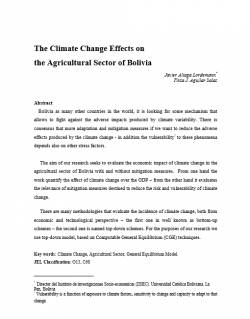The climate Change Effects on the Agricultural Sector of Bolivia
DOI:
https://doi.org/10.35319/lajed.200912160Keywords:
Climate Change, Agricultural Sector, General Equilibrium ModelAbstract
Bolivia as many other countries in the world, it is looking for some mechanism that allows to fight against the adverse impacts produced by climate variability. There is consensus that more adaptation and mitigation measures if we want to reduce the adverse effects produced by the climate change - in addition the vulnerability to these phenomena depends also on other stress factors.
The aim of our research seeks to evaluate the economic impact of climate change in the agricultural sector of Bolivia with and without mitigation measures. From one hand the work quantify the effect of climate change over the GDP – from the other hand it evaluates the relevance of mitigation measures destined to reduce the risk and vulnerability of climate change.
There are many methodologies that evaluate the incidence of climate change, both from economic and technological perspective – the first one in well known as bottom-up schemes – the second one is named top-down schemes. For the purposes of our research we use top-down model, based on Computable General Equilibrium (CGE) techniques.
Downloads
References
Agénor, P.R., Izquierdo, A. y Fofack, H. (2002): IMMPA: A Quantitative Macroeconomic Framework for the Analysis of Poverty Reduction Strategies”. The World Bank, Washington, D.C., pp. 3-12.
Armington, P. (1969): “A Theory of Demand for Products Distinguished by Place of Production”. Documento de Staff, Fondo Monetario Internacional, Vol XVI, No. 1, pp.159-178.
Bourguignon, F., Branson, W. y De Melo, J. (1989): “Adjustment and Income Distribution: A Counterfactual Analysis”. Documento de Trabajo No. 2943, National Bureau of Economic Research, Cambridge, MA.
Decaluwé, B. y Martens, A. (1988): “CGE modeling and developing economies: A concise empirical survey of 73 applications to 26 countries”. Journal of Policy Modeling, 10, pp. 4-12.
Dixon, P.B., Parmenter, B.R. Sutton, J. y Vincent, D.P. (1982): “ORANI: a multi-sectoral model of the Australian Economy". Documento de Trabajo No 1/06, Universidad de Melbourne. Melbourne.
Easterling, W., P. Aggarwal, P. Batima, K. Brander, L. Erda, M. Howden, A. Kirilenko, J. Morton, J.-F. Soussana, S. Schmidhuber, and F. Tubiello. (2007): Food, fibre and forest products. In: M.L. Parry, O.F. Canziani, J.P. Palutikof, P.J. van der Linden, and C.E. Hanson, eds, Climate Change 2007: Impacts, Adaptation and Vulnerability. Contribution of Working Group II to the Fourth Assessment Report of the Intergovernmental Panel on Climate Change. Cambridge University Press, pp. 273-313.
Ginsburgh, V. y Keyzer, M. (1997): The structure of applied general equilibrium models. The MIT Press, Cambridge, Mass.
Heathcote, J. (1998): “Interest Rates in a General Equilibrium Baumol-Tobin Model”. Documento de Trabajo, Univeristy of Pennsylvania, Department of Economics, pp. 3-12.
Horridge, J.M., Parmenter, B.R. y Pearson K.R. (1993): “ ORANI-F: A General Equilibrium Model of the Australian Economy”. Economic and Financial Computing, 3, pp. 71-140.
Jemio, L.C. (1993). Microeconomic and Macroeconomic Adjustment in Bolivia (1970-89). A Neostructuralist Analysis of External Shocks, Adjustment and Stabilization Policies. Tesis Doctoral, Institute of Social Studies. The Hague.
Jemio, L.C. (2001a): “Debt, Crisis and Reform”. Biting the Bullet. Basingstoke, Hampshire, pp. 3-5.
Jemio, L.C. (2001b). “Macroeconomic Adjustment in Bolivia since the 1970s: Adjustment to What, By Whom, and How? Analytical Insights from a SAM Model”. Kiel Working Paper 1031, The Kiel Institute of World Economics. Kiel.
Parry, Martin L., and Cynthia Rosenzweig (1993) "Food supply and risk of hunger," The Lancet, Vol. 342 No. 8883, November 27, pp. 1345-1347
Pereira, A. y Shoven, J. (1988): “Survey of Dynamic Computational General Equilibrium Models for Tax Policy Evaluation”. Journal of Policy Modeling, 10, 3. pp. 2-11.
Rosenzweig, J.A., L. Taylor (1990): Devaluation, Capital Flows, and Crowding-Out: A CGE Model with Portfolio Choice for Thailand. En L. Taylor (ed.), Socially Relevant Policy Analysis. Structuralist Computable General Equilibrium Models for the Developing World. Cambridge, Mass.
Shoven, J. y Whalley, J. (1992): Applied General equilibrium Analisys. Cambridge: Cambridge University Press.
Silva, A. (2004): “Monetary Dynamics in a General Equilibrium Version of the Baumol- Tobin Model”. Documento de Trabajo, Universidad de Chicago, pp. 4-11.Chicago.
Stern; et. al. (2007). “STERN REVIEW: LA ECONOMÍA DEL CAMBIO CLIMÁTICO”. HM Treasury. Londres, Inglaterra. 1005.
Taylor, L. (1990): Structuralist CGE Models. En L. Taylor (ed.), Socially Relevant Policy Analysis. Structuralist Computable General Equilibrium Models for the Developing World. Cambridge, Mass.
Thiele, R. y Piazolo, D. (2003): “A Social Accounting Matrix for Bolivia Featuring Formal and Informal Activities”. Latin American Journal of Economics, No 40, pp. 1-34.
UDAPE (2006): “Informe de Economía y Política Económica”. Ministerio de Hacienda de Bolivia. La Paz.






